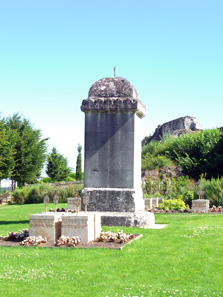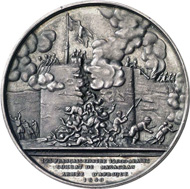By
By courtesy of Gorny & Mosch
Most people who pay a visit to the magnificent Renaissance Château d’Amboise on the Loire are usually amazed to find a Muslim cemetery right in the middle of the gardens. Who were these men? Why were they afforded such an honourable burial and how is it that, in what was a fairly intolerant 19th-century France, they were allowed to freely practice their Islamic beliefs?
To get at the story’s true beginnings, we have to go all the way back to the year 1830. At this time, France was in the process of trying to establish a colonial empire in Northern Africa. French troops were ostensibly “liberating” Algeria from Ottoman rule with the goal of ultimately bringing the country under their own control.
Muslim tombs in a French castle garden: Leonardo da Vinci isn’t the only one who lies buried in the shadows of the Renaissance castle – there are also many Algerians here, followers of Abd el-Kader, who came to France in 1848. Foto: KW.
There were many locals who were quick to doubt the apparently “noble” intentions of the French in 1830, among them, a marabout and haj born in 1807 or 1808 whose family line could be traced all the way back to the Fatimid Caliphs. His name was Abd el-Kader, and he succeeded in uniting the Berber tribes of western Algerian in battle against France. From 1832 to 1847, he led them in an open rebellion against the French.
1930 bronze plaque by G. Beguet of the 100-year anniversary of Algeria’s independence from the Ottoman Empire. Av: Fraternization of Algerian and French women and children. From the Dogan Collection, Gorny & Mosch auction 172 (2008), 6499.
Abd el-Kader won a first victory in 1834, when the French general, Desmichels, explicitly acknowledged el-Kader’s rule in a peace treaty. In 1837, the Treaty of Tafna confirmed el-Kader as an emir. But this is not to say that the war was over – by 1839, it had flared up again. The papers in France celebrated the bravery of the French soldiers, who put up strong resistance against the vastly outweaponed Berbers.
In 1844, however, el-Kader was forced to retreat to Morocco. From there, he continued to wage his guerilla warfare, only abandoning the battle once his allies had been defeated by the French. On December 22, 1847 Abd el-Kader surrendered along with his three wives and his entourage. He was brought to France along with his family and another 97 Algerians, first to Toulon and then, in April 1848 to Pau, before finally being transferred to the Château d’Amboise. El-Kader was extremely fond of France and its lushness, so much so that he was puzzled as to why the French would ever want to leave such a fertile land to conquer the desert: “I’m looking at these green, fertile plains, these orchards, streams and rivers; what abundance! Why would the French ever have any need to conquer my country of sand and rocks?”
1840 medal by Montagny of the defense of the Mazagran fortress, at which 123 French soldiers from the Berry region battled “12,000” Arabs and forced them to flee after four days of battle. From the Dogan Collection, Gorny & Mosch auction 172 (2008), 6511.
The siege of Mazagran became famous for the 123 soldiers from the Berry region who resisted “12,000” Arabs. Keep in mind, though, that the French had a walled fortress and canons at their disposal, while the Berbers attacked with mere sabres and rifles. It’s hardly surprising that after four days of battle, the latter lost interest and retreated. The French Patriots saw it quite differently, of course, and celebrated the heroes of Mazagran, showing their reverence by guzzling a mixture of coffee and Eau de Vie – said to have given the 123 countrymen liquid courage for the battle – from a specially-made mug manufactured in Bourges, called a “Mazagran” in honour of the event.
6997_5bf229bc.jpgfreigestelltPortrait of Abd el-Kader, painted by Ange Tissier, 1852.
In 1844, however, el-Kader was forced to retreat to Morocco. From there, he continued to wage his guerilla warfare, only abandoning the battle once his allies had been defeated by the French. On December 22, 1847 Abd el-Kader surrendered along with his three wives and his entourage. He was brought to France along with his family and another 97 Algerians, first to Toulon and then, in April 1848 to Pau, before finally being transferred to the Château d’Amboise. El-Kader was extremely fond of France and its lushness, so much so that he was puzzled as to why the French would ever want to leave such a fertile land to conquer the desert: “I’m looking at these green, fertile plains, these orchards, streams and rivers; what abundance! Why would the French ever have any need to conquer my country of sand and rocks?”
1845 medal of Abd el-Kader. From the Dogan Collection, Gorny & Mosch auction 172 (2008), 6521.
Abd el-Kader was honourably detained at the Château on the Loire for four years, during which time there was a change in the French government, with Napoleon III succeeding the “citizen King” Louis Philippe. Napoleon admired the model prisoner who had accepted his fate so obligingly and, in October 1952, with el-Kader swearing on the Koran to have no ulterior motives or hidden agendas, he arranged for his release.
Portrait of Abd el-Kader, painted by Ange Tissier, 1852.
El-Kader’s oath was sincere. The Algerian freedom fighter settled in Damascus, where he put his yearly pension of 100.000 francs according towards composing a religious-philosophical treatise, a French translation of which was published in 1858 under the title “Rappel à l’intelligent, avis à l’indifférent” (A reminder to the intelligent, a warning for the undecided).
In the summer of 1860, the former military leader turned scholar used his authority to bring about peace during a persecution of Christians in the Christian quarter of Damascus. All of Europe praised the one-time enemy for his valiant actions, and Napoleon III even bestowed on him the Grand Cross of the Legion d’honneur. El-Kader was now treated as an equal. He even sat alongside Empress Eugénie during the grand opening of the Suez Canal in 1869.
Abd el-Kader died, highly respected, in Damascus on May 26, 1883.










